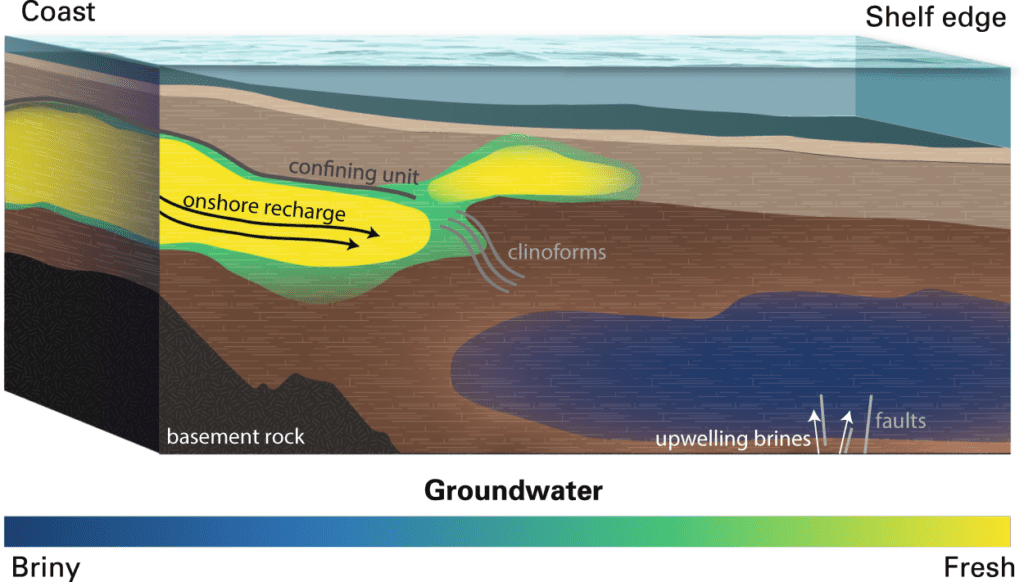A gigantic, relatively-fresh-water aquifer has been discovered just off the U.S. Northeast coast.

Yellow crosses and the yellow dashed line show the inferred spatial extent of the low-salinity aquifer system.
Image credits Chloe Gustafson, Kerry Key, Rob L. Evans, (2019), Nature.
The aquifer is contained by the sediments of the seafloor and seems to be the largest of its kind (freshwater aquifer underneath a body of saltwater) that we’ve found so far. The aquifer stretches at least from the shore of Massachusetts to New Jersey, extending more or less continuously out about 50 miles to the edge of the continental shelf, a new study reports.
Thirsty?
“We knew there was fresh water down there in isolated places, but we did not know the extent or geometry,” said lead author Chloe Gustafson, a PhD candidate at Columbia University’s Lamont-Doherty Earth Observatory. “It could turn out to be an important resource in other parts of the world.”
The first clues that an aquifer rests in this area came in the 1970s when wells drilled off the coastline in search of oil sometimes hit fresh water. At the time, it was debated whether these were isolated pockets of water or a larger continuous body. About 20 years ago, study coauthor Kerry Key, now a Lamont-Doherty geophysicist, helped fossil fuel companies develop techniques to use electromagnetic imaging of the sub-seafloor to look for oil in this area. More recently, he decided to see if the same approach can be turned to spotting freshwater deposits in the area.
In 2015, he spent 10 days on the research vessel with Marcus G. Langseth and Rob L. Evans of Woods Hole Oceanographic Institution, taking measurements off the coast of southern New Jersey and the Massachusetts island of Martha’s Vineyard, where scattered drill holes had hit fresh-water-rich sediments. Their data indicated that these were not scattered pockets of water, but a more or less continuous structure extending from the shoreline far out through the continental shelf — in some areas as far as 75 miles. For the most part, the aquifer horizon spans from between 600 feet below the ocean floor to about 1,200 feet.
Based on the readings, the team is confident that the aquifer spans not just New Jersey and much of Massachusetts, but also the coasts of Rhode Island, Connecticut, and New York. All in all, they report, the aquifer holds an estimated 670 cubic miles of fresh water. So how did all this fresh water get there? The team was two hypotheses.

Conceptual model of offshore groundwater. Arrows denote groundwater flow paths.
Image credits Chloe Gustafson, Kerry Key, Rob L. Evans, (2019), Nature.
Some 15,000 to 20,000 years ago, toward the end of the last glacial age, most of the Earth’s fresh water was locked up as ice. In North America, these ice sheets extended through northern New Jersey, Long Island, and the New England coast. Since all of that water was solid ice, sea levels were much lower, exposing large surfaces of the continental shelf that today are submerged. As the climate warmed and the ice started melting, outflowing water formed huge river deltas on top of the shelf, and fresh water got trapped there in small pockets, eventually becoming submerged under the sea bed. This is the more traditional hypothesis as to how freshwater bodies can form beneath the ocean.
However, the team has reason to believe that the aquifer is still being fed by modern runoff from dry land. Rainfall and water infiltrating from other sources percolate through onshore sediment, Key explains, and is likely pumped towards the aquifer by the cyclical motions of the tide. This hypothesis is supported by the fact that the aquifer is generally freshest near the shore and saltier the further out you go — suggesting its water gradually mixes with that from the ocean.
This water is still less salty than ocean water. Fresh water usually contains less than 1 part per thousand of salt, and this is about the value found undersea near land; on the aquifer’s outer edges, it rises to 15 parts per thousand. Typical seawater is around 35 parts per thousand salt. As such, if water from the outer edge of the aquifer would be pumped out, it would need to be desalinated — but this would still be cheaper than processing seawater, according to Key.
“We probably don’t need to do that in this region, but if we can show there are large aquifers in other regions, that might potentially represent a resource,” he explains.
Key cites southern California, Australia, the Mideast, or Saharan Africa, as some of these regions, adding that the group hopes to expand its surveys there.
The paper “Aquifer systems extending far offshore on the U.S. Atlantic margin” has been published in the journal Scientific Reports.









